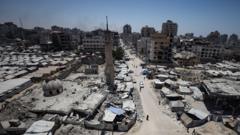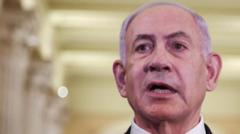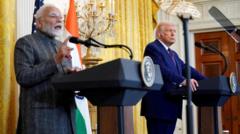Since his inauguration, Trump’s attempts at negotiating peace have been overshadowed by a significant rise in Russian attacks on Ukraine.
**Trump's Peace Efforts Contradicted by Escalating Russian Offensive in Ukraine**

**Trump's Peace Efforts Contradicted by Escalating Russian Offensive in Ukraine**
Analysis reveals sharp increase in Russian military actions despite calls for ceasefire from the U.S. President.
Despite President Donald Trump's vocal desire for peace in Ukraine, a comprehensive analysis by BBC Verify has revealed that Russian military assaults on the nation have surged since he resumed office in January. The frequency of drone and missile strikes has more than doubled compared to the latter part of the previous administration, even as Trump has repeatedly advocated for a ceasefire.
The uptick in aggression follows a steady rise in hostilities during former President Joe Biden's tenure, suggesting a broader trend of escalating violence. According to reports from the Ukrainian Air Force, Russian forces launched an alarming 27,158 aerial attacks between January and mid-July – a staggering leap from the 11,614 strikes recorded in the last six months of Biden's presidency.
Trump has often asserted that if he were in power, he could have prevented Russia's large-scale invasion by being a leader that the Kremlin would respect. However, his administration's approach to the conflict has raised eyebrows within the critique circle, particularly after two notable pauses in military support to Ukraine earlier this year. This hesitance came at a time when Russian military production capabilities expanded significantly, with a 66% increase in ballistic missile output reported over the past year.
The White House described the ongoing conflict as exacerbated by Biden's approach, insisting that Trump's administration aims to halt the violence and restore stability through military aid to NATO allies. Early indicators suggested a temporary decrease in hostilities after peaceful overtures were made towards Russia, but this abated quickly.
Diplomatic efforts led by U.S. diplomats intensified, yet with the return of violence, the urgency for a different strategy is evident. The peak of attacks occurred on July 9 when Russia launched 748 drone and missile strikes, revealing an alarming trend that has only worsened since then.
Trump’s frustrations over the situation, however, have not shifted the Kremlin's strategy, and ongoing conflicts have turned life in Ukraine into a daily struggle for civilians. Reports indicate a palpable fear among citizens, with many living in constant uncertainty about their safety.
Critics, including high-ranking Democrats such as Senator Chris Coons, assert that Trump's reluctance to maintain a firm stance with military support has emboldened Russia to escalate its operations, leading to devastating impacts on healthcare facilities and civilian structures. The lack of adequate defense systems, particularly Patriot batteries, has fueled a sense of vulnerability across Ukraine as attacks continue unabated.
In response, analysts have observed that the production of Russian aerial drones and missiles has surged, contributing significantly to the intensity of ongoing assaults. Ukrainian Military Intelligence has noted major increases in missile production, characterized by the establishment of large manufacturing facilities for drones, reflecting Russia's commitment to sustaining its offensive capabilities.
Calls for the U.S. to reinforce military support to Ukraine are growing louder, with an emphasis on enhancing security assurances and a commitment to resisting Russian aggressions. As public morale dwindles under the weight of mounting assaults, the dire situation continues to demand a decisive international response to navigate a path toward peace.
The uptick in aggression follows a steady rise in hostilities during former President Joe Biden's tenure, suggesting a broader trend of escalating violence. According to reports from the Ukrainian Air Force, Russian forces launched an alarming 27,158 aerial attacks between January and mid-July – a staggering leap from the 11,614 strikes recorded in the last six months of Biden's presidency.
Trump has often asserted that if he were in power, he could have prevented Russia's large-scale invasion by being a leader that the Kremlin would respect. However, his administration's approach to the conflict has raised eyebrows within the critique circle, particularly after two notable pauses in military support to Ukraine earlier this year. This hesitance came at a time when Russian military production capabilities expanded significantly, with a 66% increase in ballistic missile output reported over the past year.
The White House described the ongoing conflict as exacerbated by Biden's approach, insisting that Trump's administration aims to halt the violence and restore stability through military aid to NATO allies. Early indicators suggested a temporary decrease in hostilities after peaceful overtures were made towards Russia, but this abated quickly.
Diplomatic efforts led by U.S. diplomats intensified, yet with the return of violence, the urgency for a different strategy is evident. The peak of attacks occurred on July 9 when Russia launched 748 drone and missile strikes, revealing an alarming trend that has only worsened since then.
Trump’s frustrations over the situation, however, have not shifted the Kremlin's strategy, and ongoing conflicts have turned life in Ukraine into a daily struggle for civilians. Reports indicate a palpable fear among citizens, with many living in constant uncertainty about their safety.
Critics, including high-ranking Democrats such as Senator Chris Coons, assert that Trump's reluctance to maintain a firm stance with military support has emboldened Russia to escalate its operations, leading to devastating impacts on healthcare facilities and civilian structures. The lack of adequate defense systems, particularly Patriot batteries, has fueled a sense of vulnerability across Ukraine as attacks continue unabated.
In response, analysts have observed that the production of Russian aerial drones and missiles has surged, contributing significantly to the intensity of ongoing assaults. Ukrainian Military Intelligence has noted major increases in missile production, characterized by the establishment of large manufacturing facilities for drones, reflecting Russia's commitment to sustaining its offensive capabilities.
Calls for the U.S. to reinforce military support to Ukraine are growing louder, with an emphasis on enhancing security assurances and a commitment to resisting Russian aggressions. As public morale dwindles under the weight of mounting assaults, the dire situation continues to demand a decisive international response to navigate a path toward peace.
















